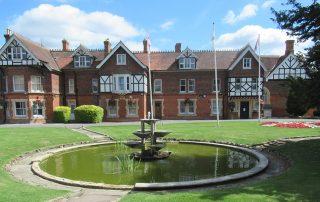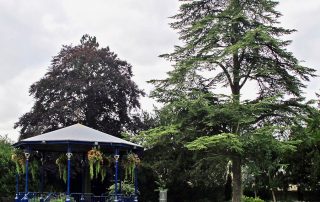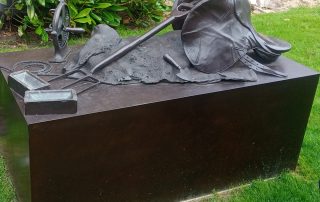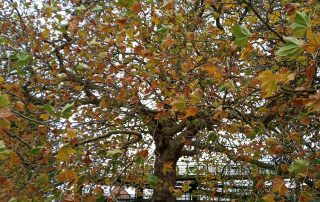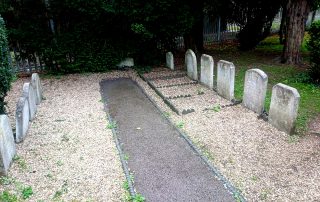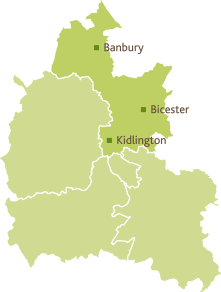Statement of significance
Garth Park is the principal public park in Bicester, Oxfordshire. Officially opened to the public in the early 1950s, it forms the parkland and formal gardens surrounding Garth House, which is occupied by Bicester Town Council. It offers a valuable green leisure space and amenities for the people of Bicester.
Historical context
Garth House and its grounds, formerly known as the Poplars, was built in the 1840s. In the 1870s, it was extensively re-modelled and extended when it became the hunting box of the Deichmanns, a wealthy aristocratic Anglo-German banking family, before eventually becoming the home of the Keith-Falconers. During World War II, the house and grounds were requisitioned by the army, with the headquarters of the Bicester Home Guard being situated at the entrance lodge. Following the death of Mrs Williamina Keith-Falconer, Garth House and its estate was bought by a group of local dignitaries and gifted to the then Bicester Urban District Council in May 1946.
The Park
The Boundaries
The 3.6ha (9 acre) park is situated between Launton Road, the Oxford to Bicester railway line and the rear of properties along the London Road. It is edged with a mixture of deciduous and coniferous trees. On the north side the park is separated from Launton Road by a two metre high stone wall which has three access points; the main entrance gate, access to Bicester Green (an eco-project and skills centre) and access to garages. It is separated from the railway line by modern metal fencing whilst other boundaries are variously made up of temporary metal fencing, wire fencing and stone walls.
Entrances
The main entrance is on Launton Road and is framed by a pair of decorative wrought iron gates. A plaque, which commemorates the “gift to the Town of The Garth and Grounds in 1946” is affixed to the left hand stone pier of the gates. To the right of the main entrance is a gate house, formerly the gardener’s lodge. On passing through the gates, to the left, there is an entrance to the former red brick stables and yard.
There are three further smaller pedestrian entrances. Two are situated at either ends of the park on Launton Road, (the Market and Railway crossing ends) and a third leads onto the London Road via Garth Court. A path at its southerly end provides access to the bowling green and tennis courts which are leased to Bicester clubs.
Horticulture
The park comprises lawns, parkland, flower beds (580 sqm in 2020) as well as specimen and native trees. Specimen trees include: Giant Redwood, Wellingtonia, Cedar of Lebanon, Blue Atlas Cedar, Tulip Tree, and Mulberry (Black) Tree. Other trees include: Cherry, Spruce, Beech, Lime, Ash, London Plane, English Oak, Horse Chestnut, Field Maple, Whitebeam, Sycamore, Hazel, Birch, Native Scots Pine, Norway Maple, Black Pine, Sorbus, Hawthorn, Rowan, Hornbeam, Deodar Cedar. Flower beds are situated to the front and western end of Garth House. Planting includes grasses, catmint, lavender, euphorbia and ceanothus. The grounds have won numerous best in bloom awards (regional) and are considered to be a showpiece for Bicester Town Council.
Current use
In addition to the formal gardens and informal parkland, there is a children’s playground, skateboard park, outdoor gym, picnic area (with wooden benches and tables), the “Savoir Fare” café, toilets and a small car park. Throughout the year, the park also hosts concerts and events such as the Bicester Festival, Christmas Light Trail and the Queen’s Platinum Jubilee Celebrations (June 2022).
Special features
There are a number of notable features scattered around the grounds. To the front of Garth House is an historic bell cast by Edward Hemins at the Bicester Foundry in 1732 (originally hung in the Shambles in the market Square), a sunken pond with a fountain donated by Bicester Rotary Club and a German telephone box gifted by Bicester’s twin town of Neunkirchen-Seelscheid in May 1990.
To the rear of the house is a bronze sculpture “In the Making” by local artists celebrating Bicester’s crafts history and a stone medieval-style font sitting atop a stone plinth. To its west is a capped well and a traditional bandstand from the foundry of WA Baker & Co (circa 1930s).
Situated on the southern boundary there is a small pet cemetery devoted to the dogs and horses of the Keith-Falconers.
A number of military memorials are sited in the formal grounds, including a decorative metal seat around a large yew tree dedicated to the memory of locals who served in the Great War of 1914-18. There are two formal beds with military insignia and a tree (sorbus aucuparia) in memory of a soldier killed in Afghanistan in 2010.
Architectural interest
Garth House is an example of a Victorian hunting-box and is now used as the offices of Bicester Town Council and a wedding venue. It is described in Pevsner Architectural Guide as
“a rambling gabled mansion of c188- also built as a hunting box…….. Brick ground floor, fish-scale tile hanging above with outbreaks of half-timbering, barge boarded dormers.” (Brooks & Sherwood 2017, p146)
Designation status
In 1998, the Bicester Town Conservation Area was extended to include Garth House and Park as it was considered “worthy of preservation and enhancement.”
Ownership and access
The Park is owned and managed by Bicester Town Council and open to the public during daylight hours.
Name of district
Cherwell
Grid reference
OS Reference SP 58915 22336
Sources of information
Bicester Local History Society (2009-2022) The Garth [Online]. Available at www.blhs.org.uk/index.php/head_history-bicester/head_buildings-of-interest/the-garth (Accessed 20 July 2022)
Bicester Town Council Garth Park [Online]. Available at: www.bicester.gov.uk/garth-park/ (Accessed 22 July 2022)
Brooks, A. and Sherwood, J. (2017) Oxfordshire north and west, Pevsner Architectural Guides, New Haven, Yale University Press
Cherwell District Council (2011) Bicester Conservation Area Appraisal [Online]. Available at www.cherwell.gov.uk/directory-record/1788/bicester (Accessed 22 July 2022)
Watts, D. and Barrington, P. (1999-2001) The changing faces of Bicester, Books 2-4, Witney, Robert Boyd


